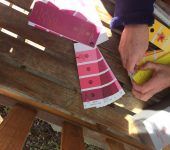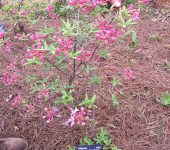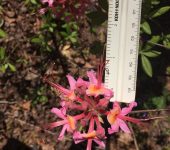The registration of Rhododendron flammeum x canescens ‘Harvey Cotten’
As some of you may know, Vernon Bush has an active native azalea breeding program in which he selects for superior qualities of bloom shape or color, earlier or later bloom period, cold hardiness, heat tolerance, fragrance, and more. In particular, he is interested in the vast differences in offspring that may be seen when R. flammeum is crossed with R. canescens. These parents can yield a group of azaleas with a very large range of flower colors and growth habits. Since these species are known to be difficult to propagate by softwood cuttings, Vernon has been working diligently with a micro-propagator in Georgia to develop tissue culture clones of his favorites for introduction. One such hybrid azalea was particularly well liked by our own Harvey Cotten, and is planted at Cotten Cove in the south end of the Bush Azalea Trail. We’ve recently completed the process of naming this azalea in honor of Harvey.
This quote from the American Rhododendron Society gives some idea of the complexity of this genus:
“In Rhododendron, there are roughly 1,000 species and over 20,000 names for cultivars (cultivated varieties). The purpose of naming is to create a unique means for referring to a cultivar. The Cultivated Plant Code provides an internationally recognized method for the precise and stable naming of cultivars.”
Registration does two main things: it records an authentic description of the cultivar to assist in identification, and prevents the duplication of an existing name (or too-similar name) or the duplication of the same plant having two names – which could cause confusion. It is recommended that a particular selection be vegetatively propagated prior to naming to ensure against loss while preserving the traits or characteristics of the original plant. The clones are genetically identical to the parent plant from which cuttings were taken. Superior forms can be selected from the wild or hybridized in breeding programs. Hybridization programs usually seek cultivars with better flowers, new colors, superior foliage, improved habits, or increased hardiness.
To register a name with the American Rhododendron Society (ARS), an application must be filed with the North American Register of the ARS. The application is reviewed for accuracy and submitted to the International Cultivar Registration Authority (ICRA). There are currently about 70 ICRA’s for all of the genera (not just Rhododendron) in cultivation. If the International Registrar approves the application, the name will then be registered. The application is deceptively short, and meticulous care is needed in the evaluation of the plant being named. The very first thing that must be done is to compare the bloom and leaf colors to one of the accepted references such as the Royal Horticultural Society Colour Chart. Etymology, or the history of the name, is another of the required fields in the form. This is used to confirm that there are no similarities to another existing Rhododendron cultivar that might cause ambiguity. Next, a thorough description (in botanical terms) must be given for the inflorescence (bloom) structure, leaf qualities, and growth habit of the plant. Every part of the reproductive anatomy must be described and measured, from the shape and number of flowers per truss to the color and size of the rachis and pedicel. Even the calyx, corolla, pistil, and stamens are measured, compared to color charts, and described by shape, fragrance, and other characteristics! Once all of this is done, the proposed name is checked for conformity to the International Code of Nomenclature for Cultivated Plants published by the International Society for Horticultural Science (ISHS), and a comparison to published cultivar descriptions is made.
It is with great pride that we recognize Vernon’s efforts and welcome Rhododendron x ‘Harvey Cotten’, officially, to our plant collection. It will take some time to propagate a quantity of this new native azalea cultivar via softwood cuttings or tissue culture; but with any luck, we may be able to start selling Rhododendron x ‘Harvey Cotten’ at our seasonal plant sales within a few years!



